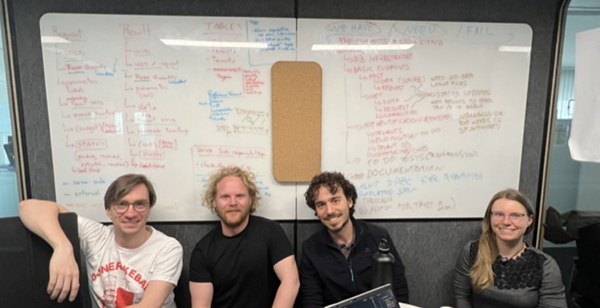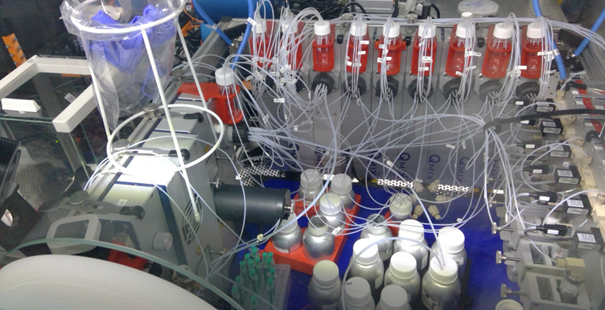Partners from DTU, EPFL, PSI, SINTEF and KIT teamed up in June 2022 to demonstrate an international materials acceleration platform (MAP) offering laboratory services through a marketplace. The operability and a proof of concept were demonstrated in an initial demonstration. The findings and lessons learned are published in an open access article1. Based on the identified means of improvement, the team revised the existing framework by restructuring the backend and improving the definition of the interfaces. The work on FINALES 2 was initiated in an intense hackathon of the server development team hosted at the Helmholtz-Institute Ulm in March 2023.

The server development team during the initial hackathon dealing with FINALES 2.
A team of BIG-MAP partners developed and deployed the Fast INtention-Agnostic LEarning Server (FINALES). This software framework provides interfaces specifically designed to connect various units of software and hardware to connect them forming a Materials Acceleration Platform (MAP). Emphasizing the collaborative spirit in this way of doing research, we refer to the connected units as tenants. One of the key design decisions made during the development of FINALES is its passive operation. FINALES does not actively trigger any actions in the MAP, but it works like a bulletin board. Users can request a service and the tenants, who offer corresponding services may pick up a request, process it and post the result back to FINALES, from where the user may collect it. This way of operating the MAP enables all the tenants to work at their own schedule without necessarily interfering with other tenants.
In several hackathons, the team prepared a demonstration , in which an optimizer developed and operated at DTU was configured to optimize electrolyte formulations for minimum density while maximizing viscosity. The optimizer posted requests for formulations to FINALES and specified, whether it would like to get experimental or computational data. Depending on its choice of the origin of the data, either the experimental setup autonomously prepared electrolyte formulations, measured density and viscosity and reported the results or the computational tenant performed its actions autonomously and reported data for ionic conductivity, density and various other quantities, which are obtained from the calculations. Once the requested results are available in the database, the optimizer started the subsequent iteration by predicting a new, promising formulation and requested new data. Since all this communication worked fully autonomous, the system was able to run these iterations for approximately 4.5 h without intervention by the researchers in the first demonstration.

An upgraded version of the pump and valve system of the setup for the Autonomous Synthesis and Analysis of Battery electrolytes experimental (ASAB) tenant, which served as the experimental tenant in the FINALES demonstration.
1. Vogler, M. et al. Brokering between tenants for an international materials acceleration platform. Matter 6, 2647–2665 (2023).